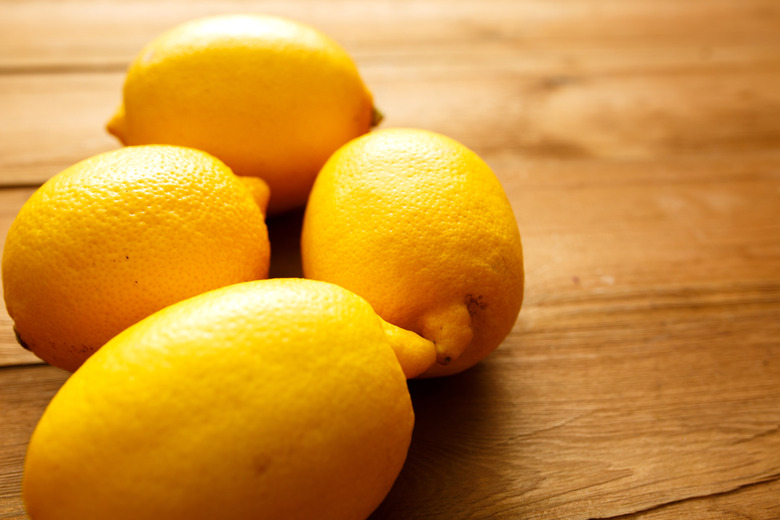White Powdery Spots On A Meyer Lemon Tree
Looking more like oranges than lemons, Meyer lemons (Citrus x meyerii) offer a sweeter, less-acidic thinner-skinned alternative to their mouth-puckering, sunny-yellow relatives. Suitable for U.S. Department of Agriculture plant hardiness zones 9 through 11, Meyer lemons grow on compact trees with white blossoms and yellow-orange fruit glowing against their glossy, deep-green leaves. They paint a pretty picture, unless white powdery spots arrive to spoil it. Treating the disease or insects responsible is relatively easy.
Step 1
Powdery mildew disease occasionally blemishes Meyer lemon's leaves and fruit with white, talcum-powder textured spots. An airborne fungus partial to cool, dry conditions, it's most active between 60 and 80 degrees Fahrenheit. Powdery mildew only attacks living plant parts. Affected leaves are likely to die and fall from the tree more quickly than uninfected ones.
Managing Powdery Mildew
Step 1
Powdery mildew spores don't survive long when the sun raises leaf temperatures above 95 F. Planting a Meyer lemon where it gets gets six hours of daily sun may be enough to thwart an infection. For organic, bee-friendly control of existing powdery mildew, thoroughly coat the leaves with a spray solution of 1 part raw or skim milk to 9 parts water. Weekly treatments when conditions favor the disease reduce symptoms by up to 90 percent, reports the National Gardening Association.
Step 2
- Powdery mildew disease occasionally blemishes Meyer lemon's leaves and fruit with white, talcum-powder textured spots.
- An airborne fungus partial to cool, dry conditions, it's most active between 60 and 80 degrees Fahrenheit.
- Powdery mildew only attacks living plant parts.
- Affected leaves are likely to die and fall from the tree more quickly than uninfected ones.
Citrus Mealybugs
Step 1
The insect version of wolves in sheep's clothing, mealybugs conceal themselves beneath layers of fluffy white wax, sink their sharp mouth parts into plants and drain them of sap and vigor. From a distance, they look like bits of cotton wool glued to the stems and leaves. A severely infested Meyer lemon may weaken and drop its fruit prematurely. An early and obvious sign of mealybug infestation is honeydew, the bugs' sticky, transparent waste. Sooty mold spores cover honeydew-coated leaves in layers of greasy, black fungus and may interfere with photosynthesis.
Mealybug Control
Step 1
Rinsing an infested Meyer lemon down with a sharp blast of hose water every few days may be enough to manage the problem. Regularly wetting the leaves also kills powdery mildew spores. Ladybugs, green lacewings and syrphid flies all prey on mealybugs. To lure them to your tree, plant nectar-and pollen-producing flowers nearby. The beneficial bugs seek out shallow-faced flowers such as sweet alyssum (Lobularia maritima), perennial in USDA zones 5 through 9, or wild bergamot (Monarda fistulosa), which grows in USDA zones 3 though 9. *If these methods don't keep the mealybugs in check,* use organic, ready-to-use insecticidal soap. In the early morning or after sundown, when honeybees aren't foraging and no sun is on the tree, spray until all the tree's surfaces drip with the soap. Repeat the application every two to three days, or at the label's suggested intervals, until the infestation is small enough for predators to control. Dress in protective clothing and eyewear and follow the label's application instructions when working with any insecticide.
Step 2
Step 3
- The insect version of wolves in sheep's clothing, mealybugs conceal themselves beneath layers of fluffy white wax, sink their sharp mouth parts into plants and drain them of sap and vigor.
- If these methods don't keep the mealybugs in check,* use organic, ready-to-use insecticidal soap.
- In the early morning or after sundown, when honeybees aren't foraging and no sun is on the tree, spray until all the tree's surfaces drip with the soap.
References
- University of Florida Nassau County Extension: Horticulture — Meyer Lemon
- University of California Sonoma County Master Gardeners: Meyer Lemon
- University of Florida IFAS Extension: Citrus Diseases Exotic to Florida — Powdery Mildew
- UC Statewide IPM Online: Powdery Mildew on Ornamentals
- National Gardening Association: Got Mildew? Get Milk!
- UC Statewide IPM Online: Citrus Mealybugs
- Missouri Botanical Garden: Mealybugs — Outdoors
- Colorado State University: Denver County Extension Master Gardener — Pest Control: Growing Plants to Attract Beneficial Insects
- Missouri Botanical Garden: Lobularia Maritima
- Missouri Botanical Garden: Monarda Fistulosa
